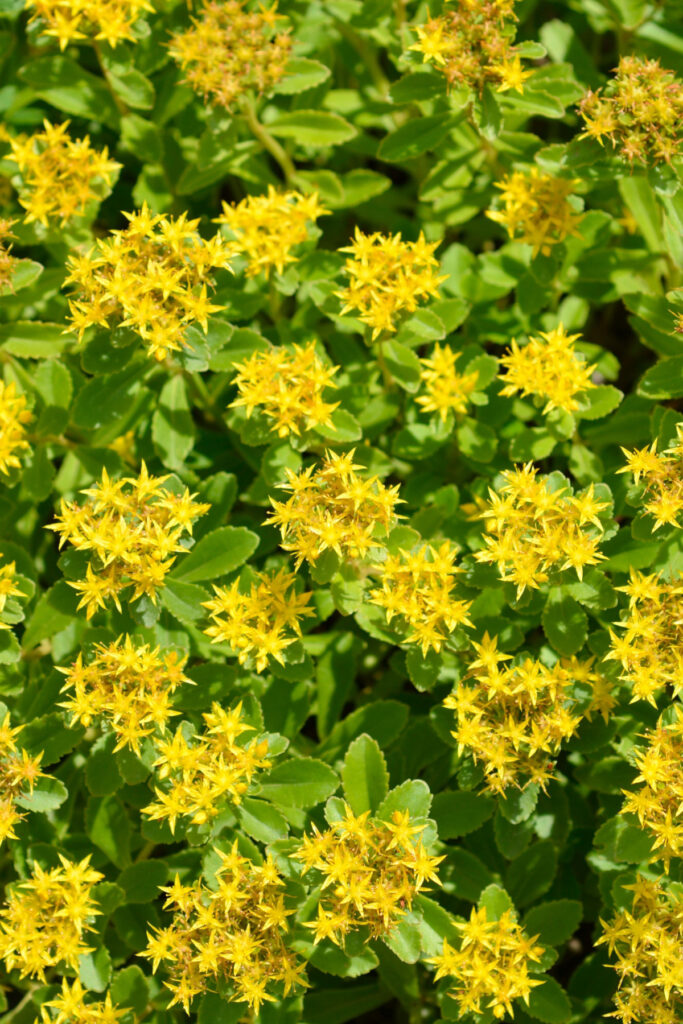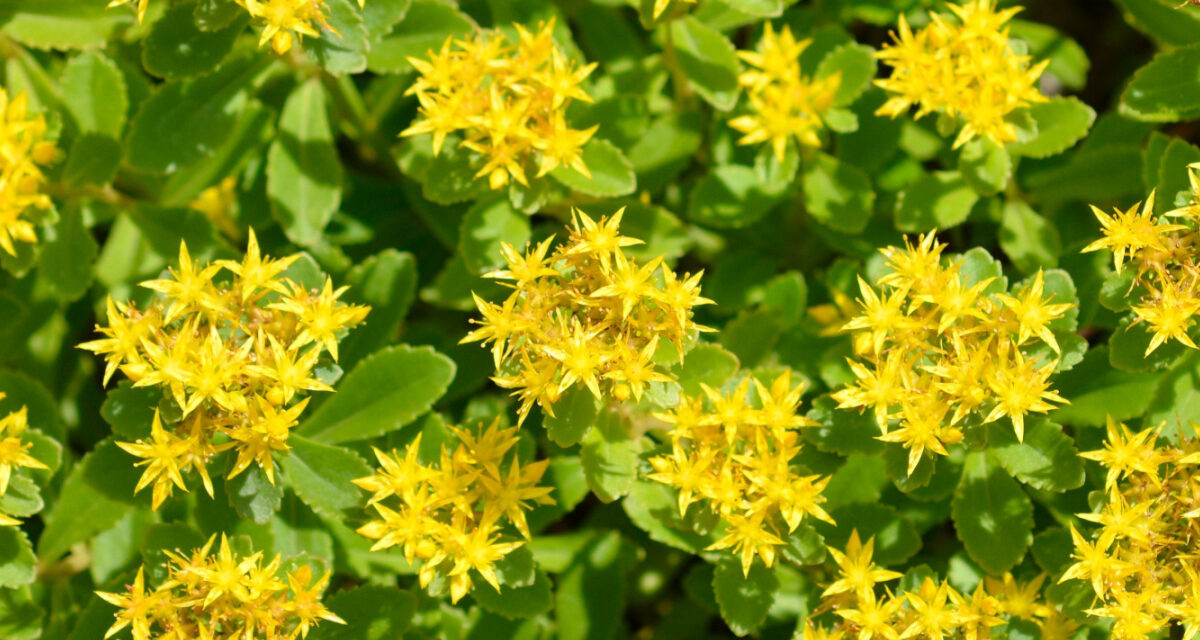An evergreen perennial, Sedum Kamtschaticum provides excellent ground cover that stems from a hardy mound. This sedum comes from the Crassulaceae family and hails from the Kamchatka peninsula in China near Siberia and high-elevation spots in Japan. Sedum Kamtschaticum makes a colorful addition to any sedum tapestry.
Are you interested in adding Sedum Kamtschaticum to your garden? Below, you’ll find everything there is to know about this sturdy yet beautiful plant, from how to care for it to the issues it can experience. Did you know that Sedum Kamtschaticum even has some medicinal properties? Read on to learn more!

What is Sedum Kamtschaticum
Sedum Kamtschaticum is a sedum plant that’s also known by the following names:
- Kamtschatka Stonecrop
- Russian Stonecrop
- Orange Stonecrop
- Phedimus kamtschaticus
- Russian sedum
- Sedum kamtschatka
Two main varieties of Sedum Kamtschaticum exist. Kamtschaticum sedum exhibits yellow flowers with deep green leaves, while sedum kamtschaticum “Variegatum” features creamy white borders around the blossoms. Most Sedum Kamtschaticum flowers are about two to three inches in size, surrounded by thick green leaves scalloped to look like elongated spoons.
Many people add Sedum Kamtschaticum to their xeric gardens for pops of color. You can easily grow Sedum Kamtschaticum from cuttings. The flowers contain seeds that often overwinter before sprouting the following spring. While Sedum Kamtschaticum does contain certain medical properties, it can cause an upset stomach if you ingest too much.
Plants Similar to Sedum Kamtschaticum
Within the sedum family, you’ll find the following plants similar to Sedum Kamtschaticum:
- Sedum album
- Sedum divergens
- Sedum rupestre “Angelina”
- Sedum pachyclados
- Sedum tetractinum
- Sedum “Dream Dazzler”
- Sedum makinoi
Many people use sedum for borders, groundcover, or rock gardens. Sedums often attract butterflies and other pollinators.
Sedum Kamtschaticum Characteristics
Mature Sedum Kamtschaticum plants measure up to 16 inches across with anywhere from five to six inches of height. While this sedum plant spreads aggressively, it’s not necessarily invasive. Sedum Kamtschaticum does well in several different climates and typically blooms from the middle of the summer into the fall.
Sedum Kamtschaticum features star-like blooms that are bright yellow or fuchsia. As fall approaches, these blooms fade to pink. With a dry summer, the flowers retain an even deeper pink tone. Depending on the weather, Sedum Kamtschaticum plants may retain their leaves as they go dormant until the following spring.
Sedum Kamtschaticum Care
You can easily grow Sedum Kamtschaticum in USDA Plant Hardiness Zones 3 through 9. This sedum requires little maintenance and easily adapts to its surroundings. It’s common to see Sedum Kamtschaticum in large containers, borders, or roof mixtures.
Sedum Kamthscaticum has a relatively shallow root system but repots easily. Pruning consists of removing diseased or damaged stems. You may also want to deadhead the flowers to encourage additional blooms. However, you should avoid planting Sedum Kamtschaticum lower than its leaves to give it plenty of room to spread out.
Sun and Soil
This sedum variety enjoys full sun at least six hours per day. Morning sunlight is best as it doesn’t contain the direct heat of the midday sun. You can place Sedum Kamtschaticum in high-traffic areas as well.
This particular sedum prefers slightly acidic soil with high organic matter content. Slow-release fertilizer works best, but you can also create a compost and peat moss mixture to use for soil. Sedum Kamtschaticum thrives in dry soil but requires good drainage for optimal growth.
Watering
Most Sedum Kamtschaticum plants don’t require a lot of water as they mature. However, you should plant Sedum Kamtschaticum within soil that incorporates rocks or crushed gravel for optimal drainage. Standing water can easily provide mold breeding grounds and lead to plant loss.
Within the first year of planting Sedum Kamtschaticum, you should water enough to prevent the plant from wilting. Be cautious of overwatering this sedum variant. Once the plant survives a year, lightly water as needed.
If you live in a dry climate with minimal summer rainfall, you should water your Sedum Kamtschaticum more often. This sedum only requires additional water during the summer months. Avoid watering in the winter until you see new growth near springtime.
Propagation
Growing additional Sedum Kamtschaticum plants from clippings or cuttings doesn’t require a lot of preparation. Learning how to plant sedum cuttings doesn’t take a lot of training.
Here’s the basic process of propagating Sedum Kamtschaticum plants:
- Take semi-ripe cuts from a mature plant.
- Cut above an upward-pointing leaf with about one or two nodes per cutting. These nodes are what will produce the Sedum Kamtschaticum roots.
- Keep the clippings moist and warm for about three weeks while they root.
- If you tug on the sprouts and they come out easily, these sedum plants are ready for transplanting. Give plants that don’t release easily a few more days to catch up.
You can also divide Sedum Kamtschaticum plants every two to three years to propagate. If you choose to divide to propagate, plan on dividing the plants in spring or early summer.
Common Sedum Kamtschaticum Issues
Pestalotiopsis is a fungal disease that affects most sedum varieties. The fungus drains nutrients from the plant, causing leaves to yellow and stems to rot. In addition, Sedum Kamtschaticum is susceptible to spider mites, leaf miners, mealybugs, and aphids. However, this sedum variety does resist rabbits and deer well.
In terms of environment, too much shade can stunt Sedum Kamtschaticum growth. Overwatering can also drown the plant. Be sure to water Sedum Kamtschaticum at the base to avoid mold growth on leaves and stems from standing water.
Summary
Sedum Kamtschaticum makes a great addition to any garden, with colorful blooms and little in the way of required upkeep. This perennial sedum thrives in dryer, acidic soils and lays dormant during the winter to bloom again come spring. Though susceptible to many common insect pests and fungal diseases, Sedum Kamtschaticum plants are one of the hardier sedums that resist even deer or rabbit predation. If you’re interested in Sedum Kamtschaticum plants, visit your local nursery to experience this gorgeous plant in person.


